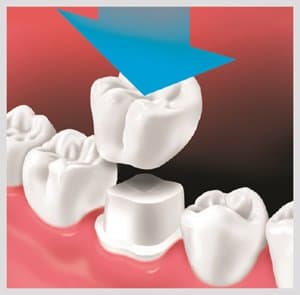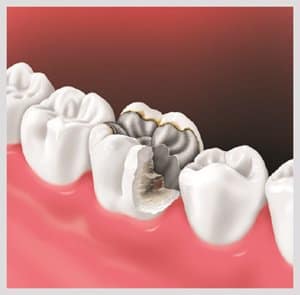Why Porcelain Crown & Bridge?
Both crowns and bridges are fixed prosthetic devices. Meaning they are cemented onto a tooth or implant, and can only be removed by a dentist. The purpose of a crown is to strengthen a damaged tooth or improve the way it looks from stains or alignment.
A crown (or cap) is a covering that encases the entire tooth surface restoring it close to its normal shape, size, and function. A crown protects and strengthens the tooth that can not be fixed with fillings or other types of restorations, or after a root canal. They are very durable and will last for many years, but may eventually need to be replaced.

There are several types of crowns, but the most popular is the ceramic (tooth colored) crown. They can be matched to the color, shape, size and sometimes straighten teeth that may be crooked. Other types of crowns are based on the material in which they are made. They include gold, metal alloys, porcelain, or metal covered by porcelain.
Reasons for a Crown
- You have a cavity that is too large to be fixed with a filling.
- You have a tooth that is cracked, broken, or worn down.
- You have a filling that is failing.
- You had root canal treatment.
- You want to cover up a discolored, badly shaped, or crooked tooth.

Steps of Placing a Crown
It usually takes 2 dental visits to complete the treatment. When a crown is placed over a natural tooth, several steps are involved.
- Your dentist prepares the tooth by removing the outer portion so the crown will fit over the tooth. Any cavity and/or old fillings will be removed at this time. If any additional tooth structure is needed to support the crown, a build up of the core of the tooth will be done.
- An impression of the tooth is made to provide the lab with an exact model for the crown. These impressions can either be a mold or a digital scan of the tooth.
- A temporary crown will be made to cover and protect the tooth while you wait for the permanent crown to return from the lab. This usually takes 2-3 weeks. While you are in a teporary crown, the tooth may be sensitive to hot and cold. Avoid chewing gum and eating sticky foods during this time.
- When your new crown is ready, the dentist will place it your mouth and make any necessary adjustments. When your dentist and you are both happy with how it looks and feels, the crown is cemented in place.



